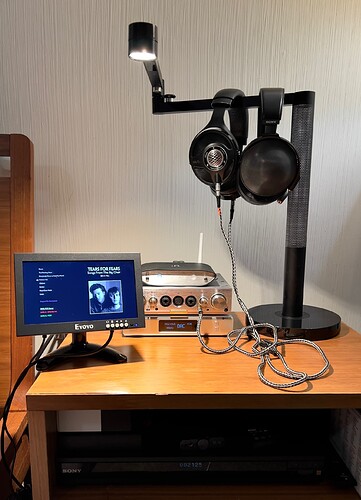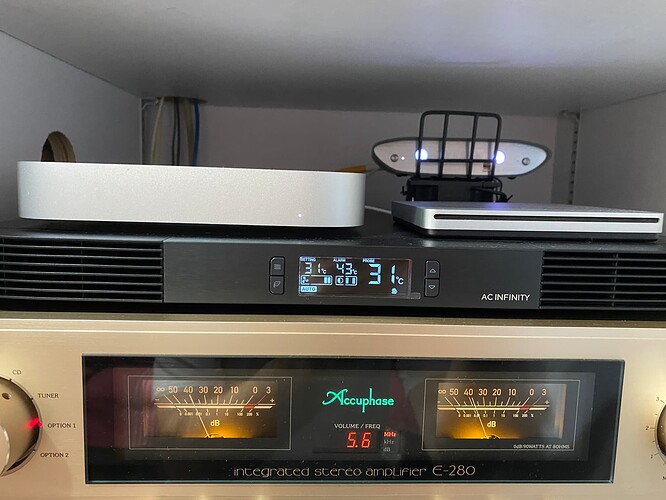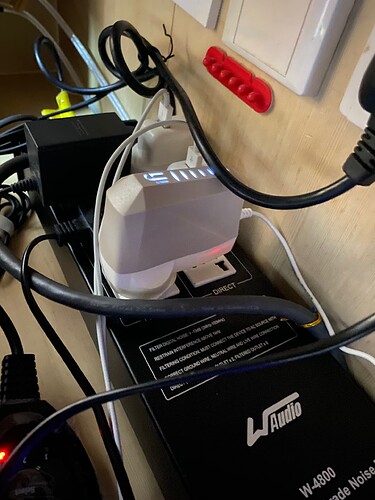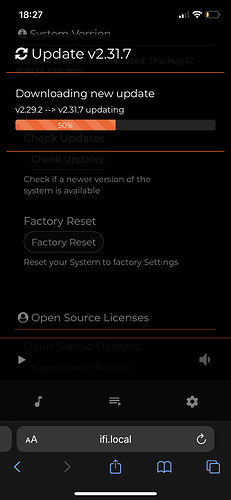For those using an EtherRegen: do you connect the ZS to the A port?
I’m so sorry you are still having trouble! I have experienced the exact same problem that you’ve demonstrated with your DSD settings, and resetting my ZS solved the problem—for me. One question I have—did native DSD ever work for you? What DAC are you using? And have you tried a different USB cable?
Not sure if other folks are aware of this, but there’s a manual making rounds that suggests that iFi has a “Neo Stream” in the pipeline—a combination of the iDSD Neo and the ZS, this time with full 786khz and DSD512 streaming and I’m guessing updated DAC chipsets (perhaps Cirrus Logic, as they moved to from Burr Brown for their latest Go Bar?) This product sounds very interesting on specs, but it would be in a different category that the ZS, since the latter is a pure streamer and the Neo is a DAC streamer—for me it would be a bit excessive as I already have a Topping D90se DAC that I’m very happy with. Price point of the Neo is unknown at this point.
However, it’s been over three months since iFi released new firmware for the ZS, and rumors are that they have either a Zen Stream v2 or a Zen Stream Signature possibly arriving soon—not sure what’s in store for this, but my spitball guesses are possibly DSD 512 streaming capability, perhaps Volumio version 3 and an HDMI port?
For those considering buying the ZS now, it’s still the best streamer you can buy for its price point (perhaps for any price point, when used with Roon). But just wanted to mention these developments in case you might consider waiting a bit to see what may be arriving in the not-to-distant future…
I’ll offer a setup guide here!
- Decide whether you have an Ethernet connection option, which is optimal. If you do, you can leave the Wi-Fi antenna in the box. If not, attach it.
- Don’t worry about which voltage power supply you’re using; the ZS has a variable voltage internal power supply that will convert any input voltage from 9-15V to the correct operating voltage.
- Remember that the ZS is nothing more than a micro-computer that exists solely in the digital realm—therefore it doesn’t have a sound. It’s merely a computer acting as a network signal transport, so beware of applying analog terms to it such as “sound signature” or “soundstage” or “warmth”.
- Ignore any claims about “burn-in” or the benefits of pricy cables—these are as unlikely to apply to this unit as they would to your keyboard connecting to your desktop. Just get a decent Ethernet and USB cable and forget about them.
- Plug in your DAC but for now keep it off. Connect your ZS to your DAC either by USB or digital S/PDIF—for higher bandwidths and versatility, the former is preferred, but either will work. I have my ZS on top of my DAC, and my amp below that, but use whatever configuration you like, preferably with the shortest USB cable possible connecting to your DAC.
- Turn on your DAC first, then plug in the ZS. Push the right button on the ZS to boot it up. For setup, make sure the device’s selector wheel on the back is set to “AIO mode” or position one.
Wired connection: If an Ethernet cable is being used, your connection setup is done. Browse to iFi.local on a device on the same network, or to the IP address of the ZS on your network—make sure that the command line doesn’t add a port address at the end (such as :3030)! If it does, remove that port instruction and try again. You should see the ZS GUI pop up.
—Go to the System Settings first and change from simple to advanced settings.
—Go to Network Settings, turn off the Wi-Fi hotspot and let it reboot.
—Then turn off the Wi-Fi radio.
—Go to Playback settings and select whether you’re using S/PDIF or USB—if you choose the latter, it should automatically show your DAC as selectable.
—If you have an MQA-capable DAC, select “MQA Passthrough”. If you don’t, turn it “On” to complete the first unfold for Tidal Connect.
—Go to System Settings and perform a system upgrade—the latest “stable” release is 2.31.7.
—The latest beta version, 2.31.8, is perfectly stable. Browse to iFi.local/dev, and enable beta updates. It’ll just blink the screen when you select it—don’t worry, it’s active. Browse back to iFi.local and perform system updates again, to get 2.31.8.
—Go back to Playback settings, select “DSD Direct” if your DAC is capable. If not select “DSD over PCM”.
—I changed my buffer settings to 64 MB and 10% to buffer before playback; play around with these settings until you get no stuttering.
—I set DSD Auto Volume Level “ON”. Don’t select Volume Normalization if you want a bit perfect signal.
—Go to Sources Menu, and turn off all the streaming services you don’t need.
—Your ZS should be fully set up now!
Wi-Fi settings
—The app that is available on both Android and iPhone App Stores will take you through the steps of setting up Wi-Fi. Make sure your device is in position one, or “AIO mode” to perform the setup process.
—If you can’t find or use the app, use your phone to connect to the ZS hotspot—you’ll know it’s active if the right tiny LED is blinking.
—Once connected to the hotspot, browse to “iFi.local”
—Go to Network Settings and select your Wi-Fi network.
—Once it’s connected, the hotspot LED should turn off.
—Turn off the hotspot radio under network settings if not.
—Follow the steps for “wired” above from here, except omit the part about turning off the Wi-Fi radio!
Roon Setup
—Change the selector dial on the back of your ZS to “Roon Only” or setting “two”. You will no longer be able to access the ZS’s GUI, that’s ok.
—Open Roon on the same network as your ZS. The ZS should appear under the Audio setup menu. Enable it.
—Don’t worry about identifying the DAC attached to the ZS in Roon. The ZS is now acting as a Roon Bridge to host your DAC as its own Roon Endpoint.
—Go into Device Settings on Roon and verify that your DAC’s capabilities have populated correctly. If your DAC is a full MQA decoder, select both rendering and decoding in the Roon MQA settings, and under advanced settings enable the first software unfold. If your DAC only has rendering capability, select that accordingly and also enable Roon’s software unfold. If your DAC is not MQA capable, select neither in Roon but still enable the software first unfold. The maximum sampling rate you will be able to achieve with the software unfold is 96khz, sometimes 48khz.
—Then on the Roon’s Audio settings page, you should see a link on the top of the enabled ZS section that says “Device Info”. Click on it. A window will pop up showing your ZS firmware version and a hyperlink to “Configure Device” Click on that. A browser window will pop up allowing you to select whether your ZS is attached via USB or S/PDIF, to choose your preferred volume controls, and to select how you prefer the ZS processes DSD streams.
That’s it! Just be mindful that if you ever need to detach your DAC from the ZS, make sure the ZS is UNPLUGGED before doing so, or it can cause connection problems when you reconnect it!
A word on the LED lights (with firmware 2.31.8)—if you’re using USB as your DAC input, the devices will communicate bidirectionally. So, if your DAC is MQA-capable, you should see the following based on the input signal:
—Standard MQA—Green
—MQA Studio—Blue
—MQA with Roon DSPs added—Magenta (OFS/MQB)
For the latter example, if you add a PEQ or other DSPs to the signal chain, Roon will perform the first unfold, then convert to 64 bit float, insert the DSP, then convert back to 24 bit and send that signal to your DAC for the final unfold. If the original track is MQA Studio (provenance), it’ll indicate as such in the signal chain—but if you’ve added any digital processing, the light on your DAC and the ZS should still be magenta.
That’s why you need to enable the software unfold in the audio advanced settings, even if your DAC is a full decoder—if you don’t, Roon won’t maintain the MQA signal past the insertion of the DSPs, and your DAC won’t receive the MQA flag.
For those who experience challenges with Wi-Fi setup using the device’s hotspot, Mr. BubbaHyde over at Head-Fi (a forum that I otherwise try to avoid like the plague) has posted a helpful alternative setup guide that many folks have found useful. The link is here:
Best of luck ![]()
I’m using a DAC-60 card on an Accuphase. I’m ok DoP at 128, but seems my DAC can only reach 256 by ASIO on Windows and Markerless DSD with is a proprietary technology from Melco Audio. Many thanks! DSD 128 is very good! Got the Power x 12v and it made a great improvement too!
BTW I’m using the latest Beta Version on Zen Streamer with HQPlayer as NAA and it’s been stable as rock
Steven it’s good to know that they will continue the development and maybe even a Signature followed by a v2 as they did that with the original DAC.
Though I am guessing might be too much to hope for and might cause confusion in the market.
A higher end true all in one that matches up against the Matrix Audio at a significantly lower price point would be amazing.
Hopefully exciting times ahead.
Hi Michael! Based on the release dates of the Hip DAC v1 and v2 and the Zen DAC v1 and v2, iFi seems to maintain a product cycle of around 14-18 months. The ZS was released in April of 2021, which means we’re about 14 months in. They’ve also really accelerated their new product output in an astonishing way over the last two years, and it’s odd for them to have abandoned new firmware cycles for over four months on the ZS (especially since their last released build is a beta).
Mr. BubbaHyde, who has become sort of an informal guru for the ZS on Head-Fi with the considerable approbation from iFi themselves, recently announced that he was leaving the ZS product page on there in anticipation of an upgrade imminent. IFi is remaining mum on this. Someone discovered the manual circulating for the Neo Stream over a month ago, so it seems likely that its release is not far away.
I also think the way they originally released the ZS with it being in unfinished form may have affected consumer confidence in the product (although they’ve certainly tidied it up since). They tend to release products in clusters at a specific price point and functionality; prior to the new budget Zen Air and Go Bar segments they refreshed their mid-tier Zen Signature and xDSD line (the latter with the Gryphon); before that was their TOTL Pro Signature line. The Neo is their one popular product that is glaringly past due for a refresh.
These are all the factors that have led me to suspect that they may have a new streamer on deck next—this category has been their weak spot (despite the ZS turning out to be a fantastic unit, their Pro iDSD streaming functions are abysmal). I do hope that if they release the Neo Stream soon, they quickly follow with a second generation ZS—I’ve gone past hope that the current ZS has the hardware capability to offer higher bandwidths and resolutions. I can’t say I would jump at the Neo Stream, given its likely higher cost and redundant features for me. But if they release a ZS refresh, given how much I’ve loved the original I’d likely grab it up sight unseen. We shall see!
Great update thanks Steven and it makes total sense.
Hopefully they are done with releasing beta products going forward as they have had bad press for it.
They lost a lot of user’s on the forum’s here, but I do think some of that was pandemic and supply chain related.
Let’s hope for great things for the next released product
All true. Admittedly a new generation ZS would be aspirational for me solely on FOMO grounds—other than upsampling to DSD 512 through Roon (which confers benefits over 256 that are fairly conclusively inaudible), the current version offers me all the streaming quality and capabilities I could ever need. Although it’s fun to watch manufacturers compete for higher and higher SINADs and more “advanced” circuitry, we reached the limits of audibility in digital audio reproduction quite some time ago!
At this point the primary limits we have to improving what hits our ears are the qualities of the masters we’re being offered via streaming sites, and the further perfection of reproduction afforded to us by our headphones. That’s the reason why I’ve saved my money on outlandishly priced streamers and DACs, and instead went for broke on my cans—at the end of the day, they are the components in our audio setups that contribute nearly all of the qualities like “sound stage” and detail and “sound signature” that many folks aspire for with futility from their DACs. ![]()
My current obsession is to find a set of headphones that will outdo my Utopias. I’m waiting for the Empyrean Elites to show up on Amazon so I can try them out with an open return policy—I would do the same for the Dan Clark Stealths if Amazon offered a version with a balanced cable…
Michael,
You said you have your ZS connected to a DAC. Then does the DAC plug into your Amplifier?
Right now I have my ZS connected directly to my Cambridge Audio CXA81 roon ready amp. So if I eventually got the new ZS with a built-in DAC, would it be better than plugging the ZS directly into my current amp? Would it work the same?
Thanks
That is how I have mine. Zenstream usb into my dac. dac output to my amp input. Using my cd audio ports currently.
set roon to stream to the zenstream. set the amp to cd.
smile like the Cheshire cat.
If your Cambridge is Roon Ready then why do you need the ZS?
Marc I have mine as a study headphone rig with two DACS connected, one via USB and one via SPDIF, but that’s just me (there is no need I just had them both lying around and it helped answer lots of questions in this thread so they have stayed there).
It doesn’t 100% need a DAC, if your amp has SPDIF on it or USB input them you could go directly into that. It really depends on your requirements and how much you then want to spend. You could add something like a Denafrips Ares II or a Zen DAC or a Cambridge Audio DAC (price points from $100 to about $700) but it would work fine without them.
Anyone else have any thoughts on this, and I guess that would depend on the quality of the DAC in your amplifier for audio quality, as an external DAC would go into the RCA cables and would subtly change the sound signature.
Another advantage of streamer is being able to make space from your computer that works as room core, have it in one room, then the streamer connected to your DAC on the living room with your amplifier and speakers, you can also have in Roon another zone with other streamer for your headphones next to your bed. Some streamers have purifier features that send also signal with less “noise” to your DAC.
My Amp doesn’t have an Ethernet port, so I have to use the streamer which does to connect to roon, then I plug the streamer into my Amp, either USB or SPDIF input to play my music through roon. It has a good built-in DAC but i thought maybe an external DAC would be better. I probably wouldn’t notice the difference if guess.
Michael,
Thanks, that is what I figured. I asked because that is how you are doing it. But I think the Cambridge built-in DAC is pretty good, and I wouldn’t necessarily want to connect an external DAC to my amp via RCA. So since I don’t want to spend a lot, I will probably forgo that experiment. Although I do have a nice DAC from my digital iPod dock going into the amp, I could see how it sounds going into that!
I’ll let you know.
Marc
If you can get a free home test then it might be worth it, but depending on the quality of the DAC in your amp it might not be an improvement, only different.
I have recently purchased an Arcam SACD player to go with my Roon Ready SA30 amplifier. Both have good DACs and I have both connected to my SA30. They sound subtly different and sometimes I prefer the RCA from the CD DAC and sometimes I prefer the SPDIF output into the SA30 DAC.
Not better but different, so it might be worth looking at, unless you already really like what you have.
Then it’s not Roon Ready.
Unfortunately I get stuck at this when trying to do a firmware update. Also did a factor reset and tried again - same result :-/
Any idea?
What is happening when you do a firmware update, what kind of message do you get?
So make sure it is set to DHCP networking and that it has a DNS entries enabled.
If everything fails try adding /dev to the URL and seeing if that works as the beta version will install then.
Edit: So it is starting but not finishing, this was common with early versions, but I have not seen it for a long time.



